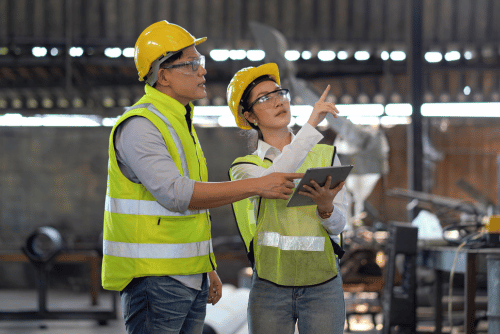Home
Resources
Health & Safety
- What is the Difference Between a Health and Safety Audit and an Inspection?
What is the Difference Between a Health and Safety Audit and an Inspection?
- Health & Safety

Ikram Mohamed, Principal Health & Safety Advisor
(Last updated )


Ikram Mohamed, Principal Health & Safety Advisor
(Last updated )
As an employer, one of your main responsibilities is to keep your employees, and anyone who visits your place of business safe. Prioritizing health and safety in your workplace will directly impact productivity, employee well-being, and legal compliance. Additionally, the Canadian health & safety legislation requires employers to have a health & safety program in their workplace. This includes having an
occupational health and safety
(OHS) policy that incorporates safety inspections and safety audits.
What is the difference between safety inspections and safety audits?
While sometimes used interchangeably, safety inspections and safety audits are quite different. In this blog we will explore the differences between a safety inspection and a safety audit, and how to remain compliant with OHS Act regulations by doing both.
What are workplace health inspections?
The aim of OHSA regulations is to prevent workplace accidents and injuries before they happen. Workplace inspections help to prevent accidents through the examination of workstations, equipment, and facilities on a regular basis. There are two types of workplace health and safety inspections – internal inspections and external inspections.
What do internal workplace health and safety inspections include?
Identifying and documenting potential and current hazards from buildings, the environment, equipment, processes, and practices
Highlighting hazards that require immediate attention
Deciding if current hazard control measures are effective and operational
Recommending adjustments where necessary
Your workplace safety inspections should be a part of a larger hazard prevention program, which includes several types of inspections.
Spot inspections
– Focused on particular safety hazards associated with specific work areas or stations.
Pre-operation inspections of special equipment
– Done prior to the actual inspection and includes equipment checks for work that will be done under water or in a restricted area.
Critical parts inspections
– Involves regular inspection of critical parts of an equipment, machine, or system that has the potential to cause serious injury or harm.
New equipment inspections
– Tests and checks done by a manufacturer or installer prior to workers starting up or using any new equipment.
Routine inspections
– Carried out on a regular basis in specific work areas, and covers all working conditions, including hazards, practices, and processes.
What do external health and safety inspections entail?
Internal and external inspections typically follow a similar approach. External health and safety inspections involve government bodies and external auditors conducting careful assessments of worksites. They are also usually done without much notice, as to maintain authenticity of the findings. The inspector will make recommendations based on the findings, however, infractions and non-compliance could lead to citations, fines, and other penalties.
What is a workplace health and safety audit?
While a safety inspection provides an overview or routine “check-up” of workstations, workplace audits involve a more comprehensive, thorough assessment of safety performance, policies, and procedures.
Benefits of workplace safety audits
Safety audits are critical for providing a detailed look at workplace safety compliance and identifying areas of concern for workers. Some additional benefits include:
Pinpointing systemic issues and underlying causes
Improving safety management systems
Supporting ongoing improvement in safety management and performance
What are the differences between a safety audit and safety inspection?
Below we have further outlined a few differences between an audit and inspection.
In order to remain compliant with the Occupational Health and Safety legislations and keep your employees protected, it is imperative that you conduct frequent inspections and in- depth audits of your workplace. It is always best if issues arise during these inspections rather than after an accident or injury.
Do you need help conducting a health & safety audit or preparing for an external inspection?
Avoid costly fines for OHSA non-compliance. We can help you pass surprise inspections with ease.
We provide support and expert advice to keep your business health and safety practices up to code. If you have an urgent problem, our certified health & safety advisors will be happy to work with you to solve it. Our experts can also assist you with company policies and with any other
human resource management
,
health & safety
, or employment advice you may need. To learn more about how our services can benefit your business, call us today at
1 (833) 247-3652.
Related articles
- November 14th 2025A Small Business Guide to WCB Alberta: Registration, Coverage, and Claims Employer adviceMichelle Ann ZoletaHealth & Safety Team Manager

- November 12th 2025Cognitive Fatigue: The Hidden Safety Hazard You Shouldn’t Ignore Workplace Health & SafetyIkram MohamedPrincipal Health & Safety Advisor

- November 10th 2025Office Holiday Party Planning: HR Dos and Don’ts for EmployersHR PoliciesKiljon ShukullariHR Advisory Manager

Back to resource hub
Try Peninsula Canada today
Find out what 6,500+ businesses across Canada have already discovered. Get round-the-clock HR and health & safety support with Peninsula. Click below to unlock free advice, policies, e-learning, and more.
Speak to an expert